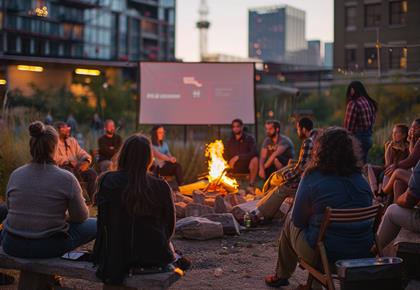Table of Contents
Why Images Grab Our Attention
Think about when you're scrolling on your phone. What makes you stop and look? Often, it's a picture. Pictures can show emotions, ideas, and products in a way that words sometimes can't. They can make us feel happy, surprised, or even want to buy something.Humans are visual creatures by nature, and our brains are wired to process visual information more efficiently than text. The human brain can identify images seen for as little as 13 milliseconds, according to researchers at MIT.
This rapid processing capability is a remnant of survival instincts, where quickly recognizing a friend from a foe or a safe path versus a dangerous one could mean life or death. In the digital age, this translates to images capturing our attention more readily than text. Visual cues serve as a type of shorthand for conveying messages.
A compelling image can evoke a spectrum of emotions, set a mood, and communicate complex ideas at a glance. Vibrant visuals act as beacons amidst the sea of textual information, often inducing quicker emotional responses and aiding in decision-making, which is essential in marketing.
Nike
Nike has harnessed the power of visual storytelling to great effect. Their "Just Do It" campaign didn't just sell shoes; it sold a lifestyle. By associating their brand with powerful images of athletes in the throes of determination and victory, Nike created an indelible link in consumers' minds between their products and the exhilarating feeling of success.
These visuals transcend language barriers and resonate on a global scale, fostering a sense of shared identity and community among Nike's customers. The "Just Do It" campaign, complemented by striking imagery of personal triumphs, has not only inspired athletes but also motivated individuals from all walks of life to strive towards their own goals, making it one of the most successful branding campaigns in history.
A picture is worth a thousand words; an inspiring picture is worth a thousand motivations.
How Images Can Tell Your Brand's Story
Your brand is like a story. And every story is better with pictures. Images can tell that story in a snap. They show your style, your colors, and what you stand for. This helps people remember who you are and what you do.Images are not just placeholders,they are powerful storytellers in their own right. A well-crafted image can convey the essence of your brand—the personality, values, and the journey—without a single word. They can encapsulate your brand's history, its present, and its aspirations.
Images offer a visual treat that can trigger emotions and create connections that resonate with the audience on a personal level. For instance, a brand that stands for sustainability can use images that feature earthy tones and nature motifs, instantly communicating its commitment to the environment.
Furthermore, consistent visual themes in imagery can build brand recognition. Consistency in style, color, and subject matter across all platforms can create a visual lexicon unique to your brand, making it instantly recognizable to your audience.
This visual consistency helps weave a cohesive story that customers can follow and relate to over time, strengthening brand identity and loyalty.
Airbnb
Airbnb's use of imagery to convey their brand story of belonging and unique travel experiences is an instructive example. Through their website and campaigns, they don't just show pictures of accommodations; they curate images that capture the experience of staying in neighborhoods around the world, from cozy apartments to treehouses.
Each image is carefully selected to tell a part of the Airbnb story, focusing on the diversity of experiences and the connections travelers can make. These images go beyond showcasing a product—they evoke a sense of adventure, community, and the comfort of feeling at home anywhere.
This visual storytelling method has contributed significantly to Airbnb's brand identity, making it one of the most recognized travel brands globally.
Each image is a thread that weaves together the story of a brand, making it both seen and felt.
Making Connections with Images
When we see an image that we like, we want to share it with friends. This is good for your brand because more people see your message. It's like when someone likes your photo and shows it to others; your brand gets more fans.Images possess the unique ability to transcend the barriers of language and culture, making them a universal medium for connection. The images that represent your brand can become conduits for interaction and sharing, harnessing the innate human desire to communicate visually.
When an image strikes a chord with viewers—whether through beauty, humor, inspiration, or sheer creativity—they are often compelled to pass that visual experience on to others. This act of sharing can amplify your brand's reach far beyond its initial audience, as each share carries an implicit endorsement, multiplying the image's impact.
By tapping into the networks of individuals, a single image can travel through various social circles, exposing your brand to diverse groups of potential customers. Moreover, shared images can foster a community around your brand, as people who share your content often feel a personal connection to your brand's visual narrative.
GoPro
GoPro has mastered the art of making connections through images by encouraging users to share their adventures captured with their cameras. These user-generated photos and videos often feature breathtaking landscapes, extreme sports, and personal achievements, aligning perfectly with GoPro's brand identity of adventure and exploration.
By sharing these visuals, users are not only celebrating their own experiences but also actively participating in and expanding GoPro's brand story. Each shared image underscores the message that with GoPro, anyone can be a hero in their own adventure. This strategy has turned GoPro's customers into brand ambassadors, their shared images a testament to the product's ability to capture life's most exhilarating moments, thereby driving brand engagement and loyalty.
Standing Out in a Busy World
There are so many brands out there. How can you be different? Images can help. A great photo or design can make someone stop and notice your brand in a busy place like a shopping mall or the internet.Our screens are filled with ads and brand messages, it's easy to get lost in the noise. That's where images come in—they can be like a bright light in a crowded room. A good image can make your brand pop out. It can be something simple like a logo that catches the eye or a photo that makes someone feel something special.
For example, if you're selling bikes, a picture of someone having fun riding can make people think, "I want to feel that too!" Images can show off your brand's personality and what you're about better than just words. They can be a shortcut that helps people see what's cool or different about what you're offering.
McDonalds
Take the famous yellow arches of McDonald's. You can be driving down a busy street, and even from far away, you'll see those arches and know there's a place to eat. They don't even need to say "McDonald's" because the image tells you everything.
It's a simple design but super powerful. It stands out and makes you think of happy meals and quick snacks. McDonald's has made those golden arches famous all over the world, and that's because they understood that a good image can say a lot and make your brand easy to find and remember.
A standout image is like a friendly face in a crowd—it's what we look for and move towards.
What You Can Do
Here's what you can do to use visual marketing:- Know Your Story:
What is your brand about? Choose images that show this clearly. - Be Consistent:
Use the same colors and style so people know it's you. - Keep It Simple:
Sometimes, a simple picture can say a lot. - Get Creative:
Try new things with your images to surprise people. - Ask for Shares:
When people like your image, they might share it. Don't be shy to ask!
Web Stories
Web Stories are like little books for the internet that tell a story with pictures and sometimes a bit of text. They're great because they can be really fun to look at and easy to flip through. You can tap on your phone or click with your mouse, and it's like turning the pages of a picture book.This is cool because because lots of people like to see stories this way, especially when they're using their phones and have just a few minutes to spare. It's not too much reading, just looking at nice pictures and getting the story quickly. Plus, these stories can show up when people search on Google, so if someone is looking for something you know about or sell, your story might pop up for them to see.
Web stories are like those short, snappy videos you see on Instagram Reels or TikTok, but they're special because you can put them on blogs, websites, or send them in messages. They're perfect if you want something that's fun and quick to watch, like a mini-movie, but also lets you share a bit more information, like a blog post does.
Examples
An example of when this worked really well is with a clothing store that made a Web Story about summer outfits. They put together a bunch of pictures showing off their clothes for hot weather. People looking for summer style ideas could easily click through and see all the different outfits.
The pictures were bright and colorful, and they showed people having a good time in their clothes, which made viewers think, "Hey, I could look that cool too!" And because Google shows these stories to people searching for summer clothes, the store got a lot more people visiting their website. It was like putting a fun, mini-magazine right in the hands of people who were already interested.
Get inspired:
1000+ Web Stories
1000+ Web Stories
Google Web Stories are like a pocket-sized gallery, where each swipe is a new window into a story you want to tell.
Conclusion
Using images in marketing is a smart move. It can make people notice you, remember you, and share your story with others. Start with a good picture and let it do the talking for your brand.
Most GTM strategies fail because they’re generic and boring. The secret to a killer go-to-market strategy? Pick an enemy. Rally your audience against inefficiency, high prices, or boring competitors. Build a brand that fights for something.

Growing a business in a niche market is a different game. Partnerships, focus, and authenticity are key. Here’s how to do it right

Technology or human touch? Many startups lose their magic with customers as they grow.Learn the secrets to scaling without losing their loyalty.
![Top 10 Client Objections and How to Handle Them [2024 Edition]](/images/blog/top-10-client-objections-and-how-to-handle-them.jpg)
Facing client objections can be frustrating, but they are a natural part of any business interaction. Instead of seeing them as roadblocks, view them as opportunities to better understand your clients and improve your approach.

Ever wondered how a story can turn an unknown gadget into a must-have? 🤔 Discover the art of storytelling in marketing unconventional products!

Absolutely vital for any business looking to get better: Closing the customer feedback loop. 🎯 Discover the 7 key steps top companies like Apple, Amazon, and Google use to effectively harness customer insights!

